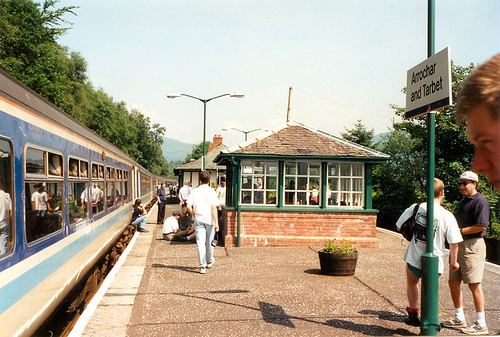Place Arrochar & Tarbet Station code ART 2011/12 9,520 Number of platforms 2 | Grid reference NN311045 2012/13 9,232 | |
 | ||
Address Arrochar G83 7DA, United Kingdom Similar Ardlui railway station, Garelochhead railway station, Helensburgh Upper railway st, Upper Tyndrum railway st, Crianlarich railway station | ||
Arrochar and Tarbet railway station is a railway station on the West Highland Line in Scotland. It stands between the villages of Arrochar and Tarbet.
Contents
History
Opened to passengers on 7 August 1894 by the West Highland Railway, then run by the North British Railway, it became part of the London and North Eastern Railway during the Grouping of 1923. The station then passed on to the Scottish Region of British Railways on nationalisation in 1948. Under NBR & LNER auspices, the station was the terminus of a local service from Craigendoran (Upper) as well as being served by through trains to Fort William & Mallaig. Known as the Wee Arrochar, the Craigendoran service was continued by British Rail until June 1964, when it fell victim to the Beeching Axe.
When Sectorisation was introduced in the 1980s, the station was served by ScotRail until the Privatisation of British Rail.
The station was laid out with a crossing loop and an island platform. The sidings on the east side of the station were used for loading timber until December 2008 when the carriage of Scottish timber by rail ceased in connection with the recession. As of June 2015, there is still no sign of the service being reinstated.
When the platform was extended southwards, the redundant signal box was relocated slightly further north for use as a waiting room. In 2000, a replica of the signal box was built in the centre of the island platform, after the station building had to be demolished due to subsidence.
Signalling
From the time of its opening in 1894, the West Highland Railway was worked throughout by the electric token system. Arrochar & Tarbet signal box, which had 17 levers, was situated on the island platform.
The semaphore signals were removed on 19 January 1986 in preparation for the introduction of Radio Electronic Token Block (RETB) by British Rail. The RETB, which is controlled from a Signalling Centre at Banavie railway station, was commissioned between Helensburgh Upper and Upper Tyndrum on 27 March 1988.
After the signal box closed, the lever frame was removed for re-use on the Leadhills and Wanlockhead Railway.
The Train Protection & Warning System was installed in 2003.
Services
Mondays to Saturdays, there are six services to Oban, three to Mallaig (combined with three of the Oban trains) and one service to Fort William (the Highland Caledonian Sleeper) northbound. Southbound, there are six services to Glasgow Queen Street (High Level) and one service to London Euston via Queen Street (Low Level) and Edinburgh Waverley (the Highland Caledonian Sleeper does not run on Saturdays). On Sundays, there are three train northbound to Oban all year and one or two to Mallaig (depending on the time of year) and three trains southbound to Glasgow Queen Street H.L and one to London Euston (which carries seating carriages as well as sleeper coaches and calls at Queen Street L.L & Edinburgh to set down).
